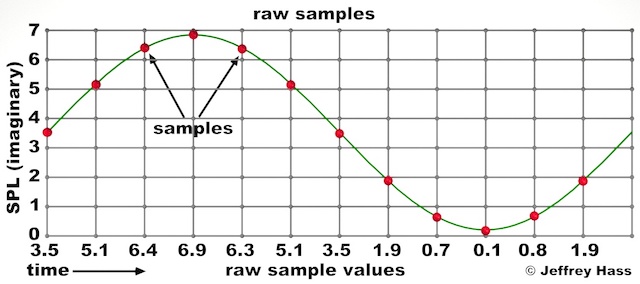Chapter Five: Digital Audio

3. Samples and Sampling
Sounds from the real world can be recorded and digitized using an analog-to-digital converter (ADC). As in the diagram below, the circuit takes a sample of the instantaneous amplitude (not frequency) of an analog waveform (in this case, for simplicity, a sine wave). Via whatever capture system, the real-world sound pressure fluctuations (SPL's) have been converted to an analog electrical stream. The digital circuit then takes sequential snapshots, called samples of that stream in a process called sampling. Alternatively, digital synthesis software can also create samples by modeling and sampling mathematical functions or other forms of calculation. These are often read into and stored in a wavetable, where they can be read similarly to real-world sound.
A sample, pictured as red spheres below, is defined as a measurement of the instantaneous amplitude of a real or artificial signal, represented below by the values labeled raw sample values, as they have not yet been converted to digital values. Frequencies will be recreated later by playing back the digitized sequential sample amplitudes at a specified rate in much the same way movement in film is created by playing back a sequence of still images called frames. It is important to remember that frequency, phase, waveshape, etc. are not recorded in each discrete sample measurement, but will be reconstructed via the playback of the stored sequential amplitudes.

Samples are taken at a regular time interval. The rate of sample measurement is called the sampling rate (or sampling frequency). As we will see in the next pages, the sampling rate is responsible for the frequency response range of the digitized sound.
| Below is a summary of the two main digital audio parameters covered in the following sections and what they affect. |
|||
|---|---|---|---|
sample rate (samples per second)
| sample size (bit depth)
| ||
| frequency response what is the highest frequency possible to reproduce before aliasing occurs |
dynamic range what is the range from softest to loudest sound, how low is the noise floor compared to the softest sound |
||